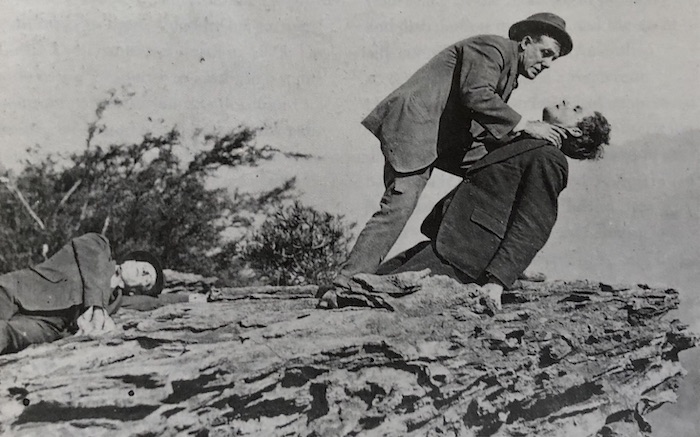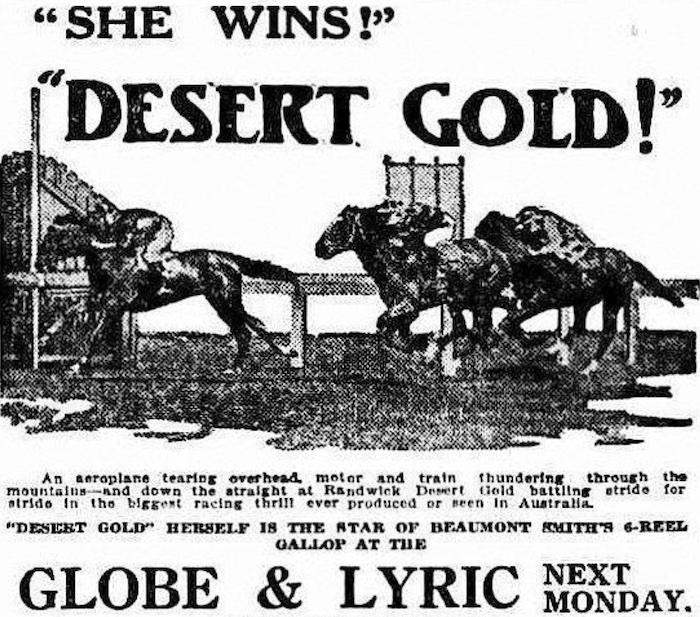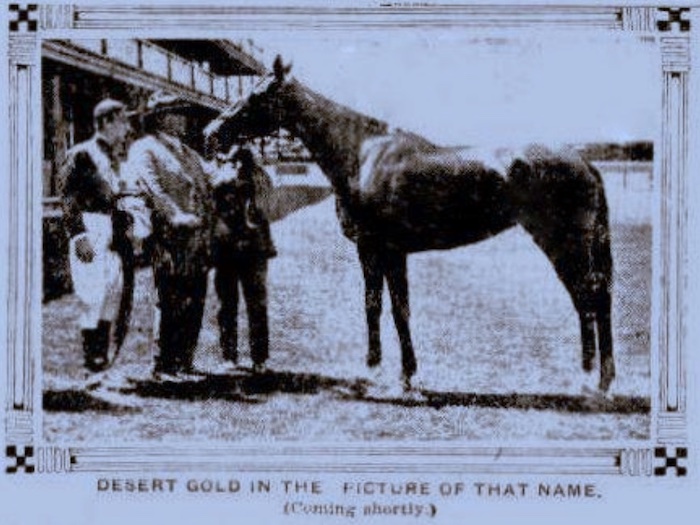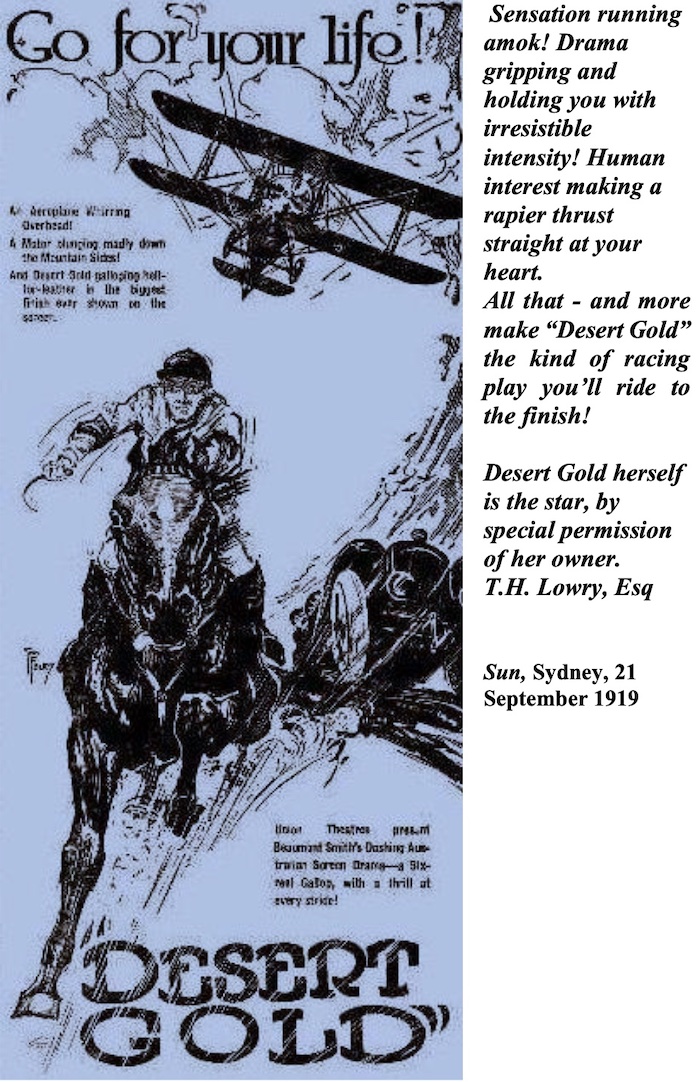

Desert Gold (Beaumont Smith, 1918) Beaumont Smith's Productions, wr. Beaumont Smith, dp Lacey Percival; Bryce Rowe, Marie Ney, John Cosgrove, Gerald Harcourt, Gilbert Emery, Desert Gold (a horse); 6 reels; no footage exists

Picture Show, 10 May 1919: 13; caption: "Dirty Work in the Blue Mountains. This scene was taken right on the edge of Echo Point. There's a clear drop of a few thousand feet if he pushes too hard, and yet they say there are no risks in movies nowadays." (Tulloch)
Pike & Cooper:
This formula horse-racing story, about gangsters trying to nobble the favourite, was primarily an excuse for racing scenes featuring the successful mare, Desert Gold. ... In addition, Beaumont Smith provided some fast-paced melodrama - a race between a car and a train, a fight on horseback in the desert and another on the brink of Echo Point in the Blue Mountains, and a climactic aeroplane flight.
Scenes were shot on location in and around Sydney and at the airforce base at Richmond. The desert scenes were staged on sand dunes at Botany Bay. Distributed by E J Carroll, the film was booked widely by Union Theatres ... In all theatres the film attracted large audiences, and Theatre, 1 November 1919, commended it as offering 'no lack of action' and 'some good race scenes and views of the Blue Mountains'. Pike & Cooper: 88.
Lawrence McCallum:
Beaumont Smith and his Silent Movie, “Desert Gold”
Between 1911 and 1949, the racehorse story quickly became the far most common genre of Australian feature film narrative with Beaumont Smith and Desert Gold being part of this (R. Fotheringham, Sport in Australian Drama, 1992, page 164). Beaumont Smith has been described as “the complete filmmaker/showman.” He wrote, directed and distributed his productions, being quickly and cheaply made, costing between £600 and £1200 (G. Shirley & B. Adams, Australian Cinema, the First Eighty Years, 1983).
When Smith had built up a sufficient package of films, he would personally tour them around Australia and New Zealand. Sometimes he enhanced their regional appeal by filming part or all of the story against local landmarks. His production schedule from first shots to post production was usually no more than a month, so capturing Desert Gold for the time she was at Randwick was not a problem. His success lay in lacing formula stories with lively and exploitable gimmicks and Desert Gold was packed with these. A gun battle, a spectacular steeplechase pile-up, “An aeroplane tearing overhead, motor and train thundering through mountains, and down the straight at Randwick, Desert Gold battling stride for stride in the biggest racing thrill ever produced or seen in Australia” (G. Shirley & B. Adams, Australian Cinema, the First Eighty Years, 1983; Advertisement, Sun, Sydney, 16 September 1919).
Tom Lowry granted Smith the use of Desert Gold on condition that a percentage of the profits went to the patriotic fund. Training and other scenes were filmed at Randwick racecourse and at Windsor stud farm, an historic landmark. Richmond Air School and the Blue Mountains were other locations.

Advertisement for the Movie, “Desert Gold” Sun, Sydney, 16 September 1919.
Those starring in the film were Marie Ney (her first film, she grew up in New Zealand and would go on to star in films in the 1950s and 60s), Bryce Rowe (whose acting career appears limited), Jerry Harcourt (who starred in sand directed a number of films and died in 1924) and the jockeys, Jack O’Shea, W.H. McLachlan and Ken Bracken. Tom Lowry would not let the actors gallop with Desert Gold and so the jockeys who were familiar with her came in to do the riding (Sunday Times, Sydney, 26 January 1919). On hand, as he had been for most of her life, was Brusher Gray looking after the mare.
One scene was where the ‘heavy’ enters Desert Gold’s stall to drug the horse. While Desert Gold was a quiet mare she had a fixed objection to strangers in her stall and would rush them with nostrils flared. Happily, said Fred Davis, this scene was taken without any harmful effect to the actor (Herald, Melbourne, 7 December 1918).

“Desert Gold In The Picture of That Name (Coming Shortly)” Sun, Sydney, 16 March 1919
The story concerns a young prospector, who with Desert Gold as his only companion, wanders into the wilderness in search of gold. His efforts meet with success although disaster nearly overtakes him because of the treachery of Harrington, a sundowner to whom he has extended hospitality at his camp. Becoming very rich and being passionately fond of horses, he decides to make racing and its thrills his particular interest in life and setting up as an owner and breeder in a large way, he soon finds enjoyment in everything. His trainer has a pretty daughter and with her he falls in love.
Everything goes along happily until Harrington again appears on the scene as a rich bookmaker and owner, possessing in addition the reputation of a racing ‘crook.’ Owing to dishonesty at gambling, he gets the trainer of Desert Gold into his schemes and finally proposes marriage to the trainer’s daughter, Joan, as the only means of saving her father from bankruptcy.
A series of dramatic scenes follow, including an exciting chase of a railway train to Katoomba and incidentally the prevention of Harrington’s marriage to Joan. Instead she is united to Desert Gold’s owner and the only disgruntled individual is Harrington, who has failed to obtain possession, not only of Joan, but also of Desert Gold. The scenic portions of the picture are interesting, the spectator obtaining glimpses of the Blue Mountains and Randwick racecourse. There are some thrilling racing views (Poverty Bay Herald, 28 March 1919).
The main actress, Desert Gold, “makes a fine film star and was not the least nervous in her initial production” (Sun, Sydney, 16 March 1919).
The movie was supposed to have opened in Sydney theatres on 16 March 1919 but was postponed so that Beaumont Smith could film and add in a few more scenes (Sunday Times, 16 March 1919). The silent movie was shown around Australia and New Zealand throughout 1919 and 1920 but all copies were lost in a fire in 1925 in Melbourne when over a million feet of film, including Desert Gold and seventy other feature films were destroyed (The Argus, 3 February 1925). Beaumont Smith would go on to make other films such as The Man from the Snowy River, While the Billy Boils, and The Betrayer, a throbbing inter-racial romance of two islands, New Zealand and Australia with shots of geysers and mud pools.

Eric Reade:
Beaumont Smith remained Australia’s most energetic producer. His second feature for the year, the racing drama Desert Gold, was delayed by the influenza epidemic and not screened until September. The undoubted star of the picture was T. H. Lowery’s racehorse Desert Gold who received excellent support from Bryce Rowe, Marie Ney and John Cosgrove. The cameras mingled with the brilliant throng in the paddock ... the wise heads of the leger... the roaring, excited mob on the flat. Identities from Tatts, crack jockeys, big punters and winning trainers gave an air of authenticity to the film.
During the shooting of the film, dry ground at Botany Bay doubled for a desert in Central New South Wales. In the script, Marie Ney’s horse shied and threw her as she galloped through the arid region, but the sequence proved too realistic and Miss Ney broke an arm. For the rest of the picture she wore her arm in a sling, but was photographed so well that picturegoers were not aware of it.
McCallum, Lawrence Robert, 'Desert Gold', excerpt from Tinkers Gully, Desert Gold, Avoch and Other Stories, due out in 2023.
Reade, Eric 1975, The Australian Screen: A Pictorial History of Australian Film-making, Lansdowne Press, Melbourne: 86.
Tulloch, John 1981, Legends on the Screen: The Narrative Film in Australia 1919-1929, Currency Press/Australian Film Institute, Sydney, 1981: 68, 71, 204, 216.
Garry Gillard | New: 28 November, 2012 | Now: 24 October, 2022